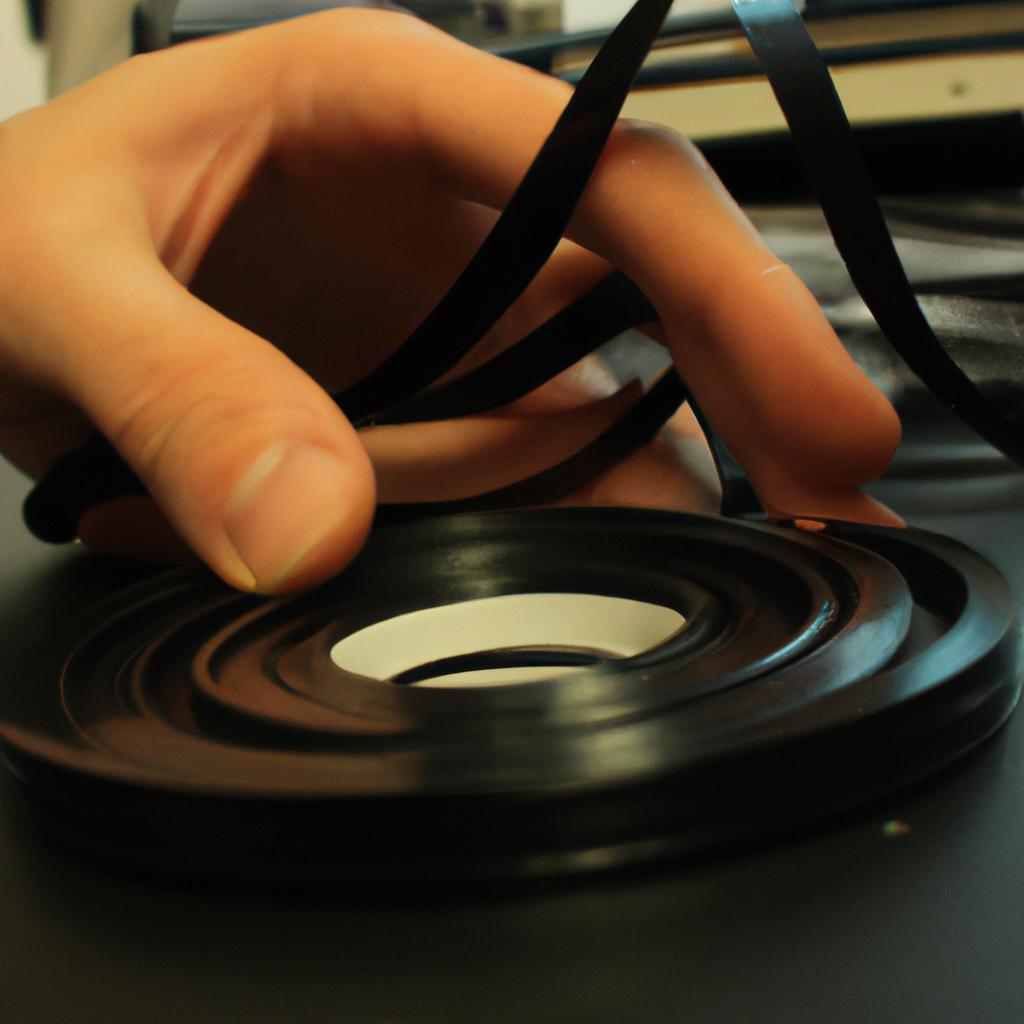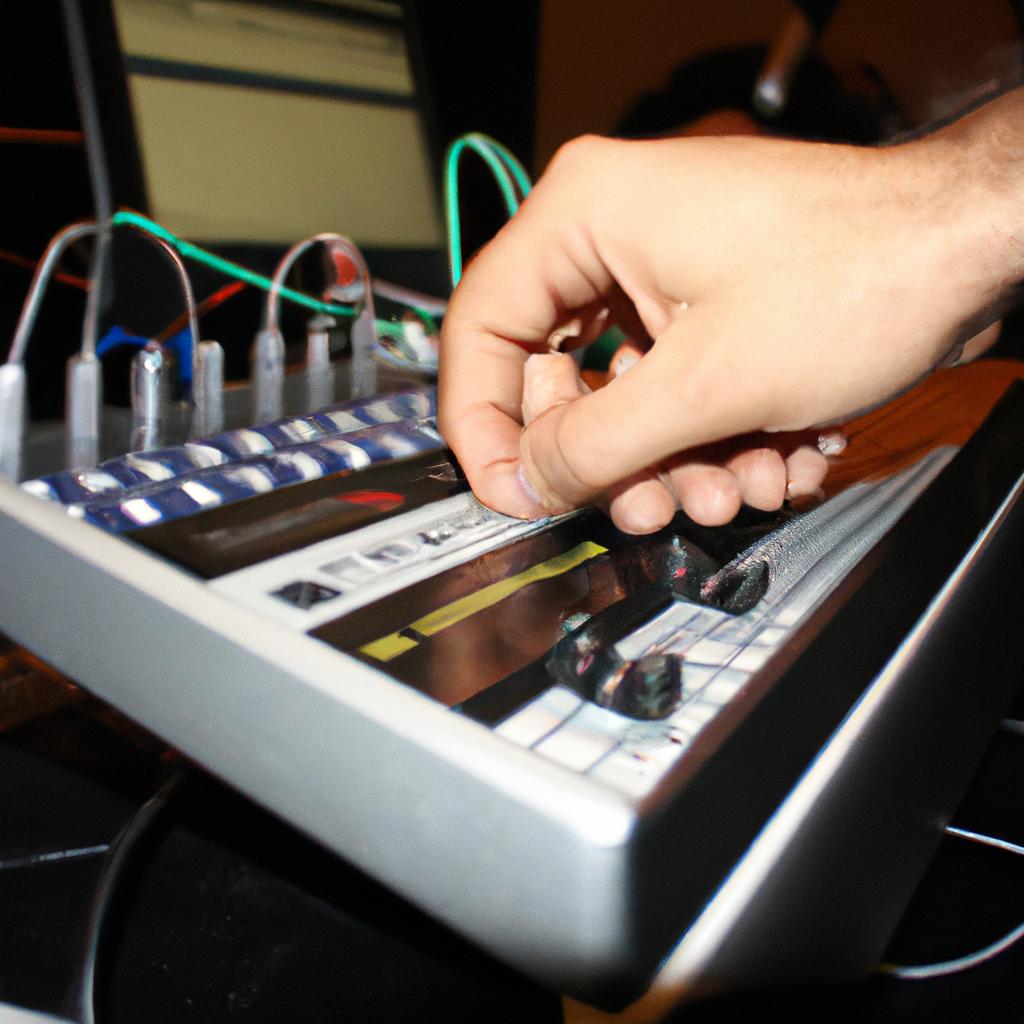Amplifier feedback and local noise music have gained significant attention in recent years due to their unconventional techniques, which challenge traditional notions of music composition and performance. This article aims to explore the various methods employed by musicians and sound artists to create unique sonic experiences through the manipulation of amplifier feedback and localized noise. To illustrate these techniques, we will examine a hypothetical case study featuring an experimental musician who utilizes amplifier feedback as the foundation for their live performances.
The concept of amplifier feedback involves intentionally creating a loop between a microphone or instrument and an amplifier, resulting in a continuous cycle of sound reinforcement that can be manipulated by the performer. By adjusting factors such as microphone positioning, gain levels, and room acoustics, musicians are able to shape the characteristics of the amplified sound and generate complex textures rich in harmonic overtones and resonances. This process not only allows for real-time exploration of timbral possibilities but also opens avenues for improvisation within structured compositions.
In addition to amplifier feedback, local noise music embraces environmental sounds and electronic interference as integral components of musical expression. Musicians working within this genre often incorporate found objects, field recordings, circuit-bent instruments, or malfunctioning equipment into their setups to introduce unpredictable elements into their sonic palette. The intentional use of local noise sources, such as electromagnetic interference or radio frequencies, adds an element of chance and randomness to the composition, further challenging traditional notions of control and intentionality in music-making.
To better understand these techniques, let’s delve into our hypothetical case study. Imagine a musician named Alex who specializes in creating immersive sonic experiences using amplifier feedback and local noise elements. In their live performances, Alex starts by positioning a microphone in close proximity to their instrument, taking advantage of its inherent resonances and acoustic properties. The microphone is then connected to an amplifier, which amplifies the sound produced by the instrument and feeds it back into the microphone.
By manipulating various parameters like gain levels, EQ settings, and effects pedals, Alex actively shapes the resulting feedback loop. They may explore different microphone positions within the performance space to interact with room acoustics or experiment with different instruments to create unique sonic textures. As the feedback loop evolves organically throughout the performance, Alex can respond intuitively by adjusting their playing technique or introducing additional sound sources.
Incorporating local noise elements into their setup allows Alex to expand their sonic palette even further. For example, they might incorporate field recordings of urban environments or electronic interference from nearby devices into their performance. By blending these found sounds with the amplified feedback loop, a rich tapestry of textures emerges that blurs the boundaries between musical instruments and environmental noise.
The result is a captivating sonic experience that challenges conventional notions of music composition and performance. Through intentional manipulation of amplifier feedback and incorporation of local noise elements, musicians like Alex are able to create unique sonic landscapes that engage audiences on both an emotional and intellectual level.
In conclusion, amplifier feedback and local noise music offer musicians and sound artists innovative methods for pushing the boundaries of traditional music-making practices. By embracing unconventional techniques and exploring uncharted sonic territories through these means, artists can create immersive experiences that challenge preconceived notions about what constitutes music while opening up new possibilities for artistic expression and exploration.
What is amplifier feedback?
Amplifier feedback refers to the phenomenon where a portion of the output signal from an amplifier is fed back into its input. This creates a loop that can affect the overall performance and characteristics of the amplifier. To understand this concept better, let’s consider an example: Imagine a guitarist playing their electric guitar through an amplifier at high volume. As they increase the gain or level on their amp, they notice a distinctive screeching sound coming from their instrument.
Amplifier feedback can have both positive and negative effects on sound production. On one hand, it can create interesting sonic textures and harmonics that are sought after in certain music genres such as noise music. Feedback has been utilized by musicians like Jimi Hendrix and Sonic Youth to push the boundaries of conventional sound manipulation.
However, excessive feedback can also result in unwanted noise pollution. It often manifests as a loud, piercing squeal or howl, which disrupts the listening experience and may even damage equipment if left unchecked. The impact of amplifier feedback largely depends on various factors including amplification settings, room acoustics, and proximity between microphone/instrument and speakers.
To illustrate some emotional responses associated with amplifier feedback:
- Frustration: Dealing with persistent unwanted noise can lead to annoyance and frustration among performers and listeners alike.
- Excitement: Harnessing controlled feedback in experimental music genres like noise rock or avant-garde electronic compositions can evoke excitement due to its unpredictable nature.
- Awe: Discovering unique sounds produced through intentional manipulation of feedback can elicit awe among musicians and enthusiasts.
- Discomfort: For those unaccustomed to extreme sonic experimentation, exposure to amplified feedback might induce discomfort or unease due to its unconventional tonality.
The following table summarizes some key aspects related to amplifier feedback:
| Aspect | Positive Effect | Negative Effect |
|---|---|---|
| Sound Texture | Unique sonic textures | Unwanted noise pollution |
| Experimental | Open doors for artistic exploration | Disrupts listening experience |
| Creative | Allows for unconventional sound manipulation | Potentially damages equipment |
| Challenging | Pushes boundaries of conventional music genres | May induce discomfort or unease |
Understanding the impact and characteristics of amplifier feedback is crucial in exploring its potential uses, as well as mitigating any unwanted consequences. In the subsequent section, we will delve into how amplifier feedback affects sound and discuss its implications in greater detail.
How does amplifier feedback affect sound?
Amplifier Feedback and Local Noise Music: Techniques
What is amplifier feedback? In the previous section, we discussed the concept of amplifier feedback and its role in shaping sound. Now, let us explore how this phenomenon affects the overall sonic experience. To illustrate this, consider a hypothetical scenario where an experimental musician employs amplifier feedback to create unique textures in their performance.
When using amplifier feedback as a creative tool, various factors come into play that influence the resulting sound. Firstly, the positioning of microphones can significantly impact the nature of feedback produced. By strategically placing microphones near speakers or instruments, musicians can manipulate the frequency response and intensity of the feedback loop. This control over tonal characteristics allows for dynamic exploration within compositions.
Additionally, different types of environments contribute to varying degrees of local noise interference when utilizing amplifier feedback techniques. For instance:
- A small enclosed space may enhance reverberations and intensify certain frequencies.
- An open outdoor area might introduce external sounds that blend with the amplified signal, creating an immersive auditory experience.
- Concert halls with specific acoustics could shape how feedback resonates throughout the space.
- Recording studios offer controlled conditions for precise manipulation and capturing of desired audio elements.
To delve deeper into these aspects, let us examine them through a table:
| Type of Environment | Characteristics |
|---|---|
| Small Enclosed Space | – Enhanced reverberation- Intensified frequencies |
| Open Outdoor Area | – Blending with external sounds- Immersive auditory experience |
| Concert Halls | – Resonance throughout space- Controlled acoustic environment |
| Recording Studios | – Precise manipulation capabilities- Capture desired audio elements |
As seen above, each type of environment presents distinct opportunities for artists to mold their soundscapes with amplifier feedback techniques. The choice of setting becomes an integral part of crafting a unique sonic signature.
In our subsequent section on “Different types of amplifier feedback,” we will explore specific variations and applications in more detail. By understanding the diverse ways that amplifier feedback can manifest, musicians can further expand their creative possibilities and push the boundaries of local noise music.
Different types of amplifier feedback
Amplifier Feedback and Local Noise Music: Techniques
In the previous section, we explored the fascinating topic of how amplifier feedback can influence sound. To further our understanding, let us delve into different types of amplifier feedback that play a crucial role in shaping the sonic landscape.
Different types of amplifier feedback:
-
Acoustic Feedback: This occurs when the amplified sound from speakers re-enters the microphone, creating a looped cycle of continuous reinforcement. Imagine a scenario where an electric guitarist plays a note that resonates with the vibrations produced by their amp. The resulting feedback intensifies and sustains certain frequencies, adding depth and richness to the overall tone.
-
Electrical Feedback: Unlike acoustic feedback, electrical feedback is caused by interactions within the electronic components of an amplifier system. It can occur due to improper grounding or faulty connections, leading to unwanted noise or distortion. For instance, if there is an issue with the wiring between an instrument and its amplifier, it may result in humming or buzzing noises being incorporated into the audio signal.
-
Spatial Feedback: This type of feedback arises from environmental factors such as room acoustics or placement of microphones relative to speakers. When sound waves emitted by amplifiers bounce off surfaces like walls or ceilings before reaching microphones, they create complex patterns of interference known as standing waves. These standing waves can enhance or attenuate specific frequencies, altering the perceived tonal characteristics.
-
Harmonic Feedback: Harmonic feedback refers to instances where certain overtones are emphasized due to resonance between various elements in an audio chain. As these harmonics interact and reinforce each other at specific frequencies, they produce distinctive timbres that contribute to the unique character of individual instruments or voices.
| Type | Description |
|---|---|
| Acoustic Feedback | Sound from speakers enters microphone causing continuous reinforcement |
| Electrical Feedback | Interactions within electronic components leading to unwanted noise or distortion |
| Spatial Feedback | Environmental factors like room acoustics and microphone placement create complex patterns of interference, enhancing or attenuating specific frequencies |
| Harmonic Feedback | Reinforcement of overtones through resonance between elements in an audio chain, resulting in distinctive timbres |
Understanding the impact of different types of amplifier feedback on sound is essential for musicians exploring the realm of local noise music. By harnessing these techniques, artists can manipulate and shape sonic textures to evoke emotional responses from their audience. In the subsequent section, we will delve into how amplifier feedback plays a pivotal role in this unique genre, analyzing its creative applications and transformative effects without limiting artistic expression.
Now let’s move on to explore “The role of amplifier feedback in local noise music.”
The role of amplifier feedback in local noise music
Amplifier Feedback and Local Noise Music: Techniques
Different types of amplifier feedback have been explored extensively in the previous section, showcasing their various characteristics and effects. Now, we will delve into the role that amplifier feedback plays specifically in local noise music, a genre known for its experimental nature and unconventional use of sound.
To illustrate this further, let’s consider an example. Imagine a local noise musician named Alex who is performing at an underground venue. As Alex starts to manipulate the controls on their guitar amplifier, intentional feedback begins to emerge. The screeching, distorted sounds intertwine with other elements like electronic beats and spoken word samples, creating a cacophony of sonic textures that captivate the audience.
In local noise music, amplifier feedback serves as both a foundational element and a tool for artistic expression. It allows musicians to push sonic boundaries and challenge traditional notions of melody and harmony. Here are some key aspects to understand about the role of amplifier feedback in this context:
- Unpredictability: Amplifier feedback introduces an unpredictable factor into the performance, adding an element of surprise for both the artist and the audience.
- Textural richness: The unique timbres generated by manipulated feedback can enrich the overall texture of local noise music compositions.
- Emotional intensity: By harnessing the raw power of amplified sound waves pushed to their limits, amplifier feedback helps create intense emotional experiences during live performances.
- Sonic exploration: Musicians utilize amplifier feedback as a means of exploring new possibilities within their sonic palette, pushing the boundaries of what is traditionally considered musical.
Table: Emotional Responses Elicited by Amplifier Feedback in Local Noise Music
| Emotion | Description |
|---|---|
| Dissonance | Evokes tension through clashing frequencies |
| Catharsis | Provides release from pent-up emotions through cathartic sonic experiences |
| Intrigue | Captivates curiosity as listeners try to decipher the complex soundscapes |
| Aggression | Conveys a sense of power and rebellion through abrasive sonic textures |
In conclusion, amplifier feedback plays an integral role in local noise music, allowing musicians to explore new realms of sonic possibilities. By embracing unpredictability and utilizing the unique timbres generated by manipulated feedback, artists can create emotionally intense experiences for both themselves and their audience. Now, let’s delve deeper into the creative uses of amplifier feedback in the subsequent section, where we will uncover innovative techniques employed by musicians pushing the boundaries of this genre.
[Transition sentence into next section: Exploring the Creative Uses of Amplifier Feedback]
Exploring the creative uses of amplifier feedback
Having discussed the role of amplifier feedback in local noise music, it is now crucial to delve into the creative uses and sonic possibilities that this technique offers. By harnessing the potential of amplifier feedback, musicians can explore a vast range of sounds and textures within their compositions. In order to illustrate this concept, let us consider an example where a musician manipulates amplifier feedback to create a dynamic and immersive musical experience.
Example scenario:
Imagine a live performance by an experimental noise artist who incorporates amplifier feedback as a central element of their set. As the artist initiates the performance, they intentionally position themselves near the amplifiers, adjusting control settings meticulously to achieve desired tonal qualities. The resulting soundwaves interact with surrounding objects and surfaces before being captured by microphones strategically placed throughout the venue. This deliberate manipulation creates a cacophony of layered frequencies and resonances that engulf the audience in an otherworldly auditory journey.
To further understand how amplifier feedback can be utilized creatively, let’s examine some key characteristics and techniques associated with its application:
- Unpredictability: Amplifier feedback possesses inherent unpredictability due to various factors such as room acoustics, instrument positioning, and volume levels. Musicians can embrace this uncertainty by allowing chance elements to shape their compositions or performances.
- Sonic exploration: Amplifier feedback allows for experimentation with timbre and texture beyond traditional musical boundaries. Musicians can manipulate parameters like gain, EQ settings, or even introduce external effects pedals to sculpt unique sonic landscapes.
- Expressive dynamics: Feedback-based sounds often exhibit dramatic shifts in intensity, ranging from subtle whispers to piercing screeches. These expressive dynamics enable musicians to evoke emotions ranging from tranquility to agitation within their work.
- Interactivity: Incorporating interactive elements into performances involving amplifier feedback adds another dimension of engagement for both musicians and listeners alike. Live manipulation of feedback parameters through physical gestures or the use of controllers can create an immersive and participatory experience.
To illustrate these points, consider the following table showcasing different elements that contribute to the sonic possibilities of amplifier feedback:
| Elements | Description |
|---|---|
| Harmonic overtones | The complex combination of frequencies produced by amplified soundwaves interacting with the environment. |
| Resonance | The prolongation and enhancement of specific frequencies due to acoustic properties within a space. |
| Feedback loops | Continuous cycles in which sound from speakers is picked up by microphones and reintroduced into the system, creating sustained tones. |
| Distortion effects | Alterations in frequency response caused by pushing amplifiers beyond their intended limits, resulting in unique harmonic distortions. |
In conclusion, exploring the creative potential of amplifier feedback opens up new avenues for musicians seeking unconventional sounds and experiences within their compositions or performances. By embracing its unpredictability, experimenting with sonic textures, harnessing expressive dynamics, and incorporating interactivity, artists can push boundaries and captivate audiences in profound ways.
With an understanding of the sonic possibilities offered by amplifier feedback, let us now delve into practical tips for incorporating this technique effectively into your own musical endeavors
Tips for incorporating amplifier feedback in your music
Section H2: Tips for Incorporating Amplifier Feedback in Your Music
Building upon the creative uses of amplifier feedback explored earlier, this section will provide valuable tips and techniques for incorporating this unique sound element into your music. By following these guidelines, you can harness the power of amplifier feedback to enhance your compositions and create captivating sonic experiences.
-
Experiment with Different Gain Levels:
Varying the gain levels on your amplifier is crucial when working with feedback. Higher gain settings tend to produce more intense and distorted sounds, while lower gain settings offer a cleaner and subtler effect. Through careful exploration and experimentation, find the optimal balance that complements your desired musical aesthetic. -
Utilize Pedal Effects:
Integrating pedal effects into your setup can significantly expand the possibilities of using amplifier feedback in your music. Effect pedals such as distortion, delay, or reverb can shape and manipulate the feedback tones in exciting ways, adding depth and complexity to your compositions. -
Control Feedback Frequencies:
Understanding how different frequencies interact with each other is key to mastering amplifier feedback. Experiment with adjusting tone controls on both your instrument and amplifier to emphasize or suppress specific frequency ranges within the feedback loop. This level of control allows you to sculpt dynamic textures out of seemingly chaotic noise. -
Combine Techniques for Artistic Expression:
The true beauty of incorporating amplifier feedback lies in its potential for artistic expression. Embrace an experimental mindset by combining various techniques like playing harmonics, utilizing volume swells, or manipulating guitar strings directly against the pickups. Explore uncharted territories and allow yourself to be surprised by unexpected results.
| Technique | Description | Example |
|---|---|---|
| Harmonic Overtones | Accentuating harmonic overtones through precise fretting techniques | Producing ethereal melodies amidst swirling noise |
| Controlled Oscillation | Manipulating oscillation patterns to create pulsating and rhythmic textures | Building tension in a climactic musical passage |
| Feedback Loops | Creating intricate sonic landscapes by feeding the output of one amplifier into another | Generating cascading layers of harmonious feedback |
| Panning | Utilizing stereo panning effects to sweep the feedback across the soundstage | Adding spatial depth and movement to the music |
By incorporating these tips, you can unlock new dimensions of creativity with amplifier feedback. Remember that experimentation is key; embrace the unpredictable nature of this technique while cultivating your unique artistic voice. Allow yourself to push boundaries, explore uncharted territories, and harness the raw power of sound.
Note: It is important to ensure proper safety precautions when working with amplified sound levels. Protect your hearing by using earplugs or earmuffs and be mindful of volume levels during experimentation.





